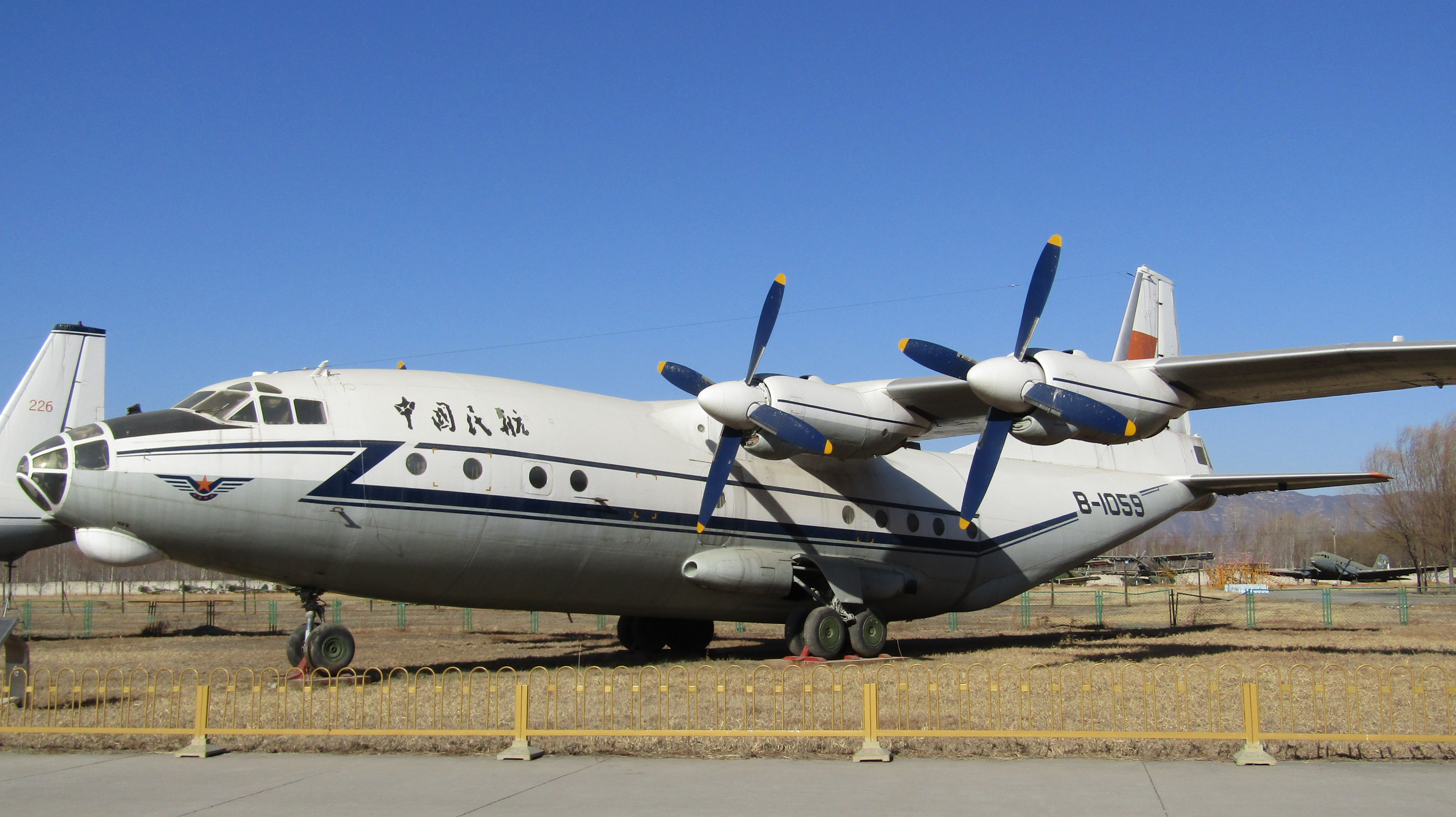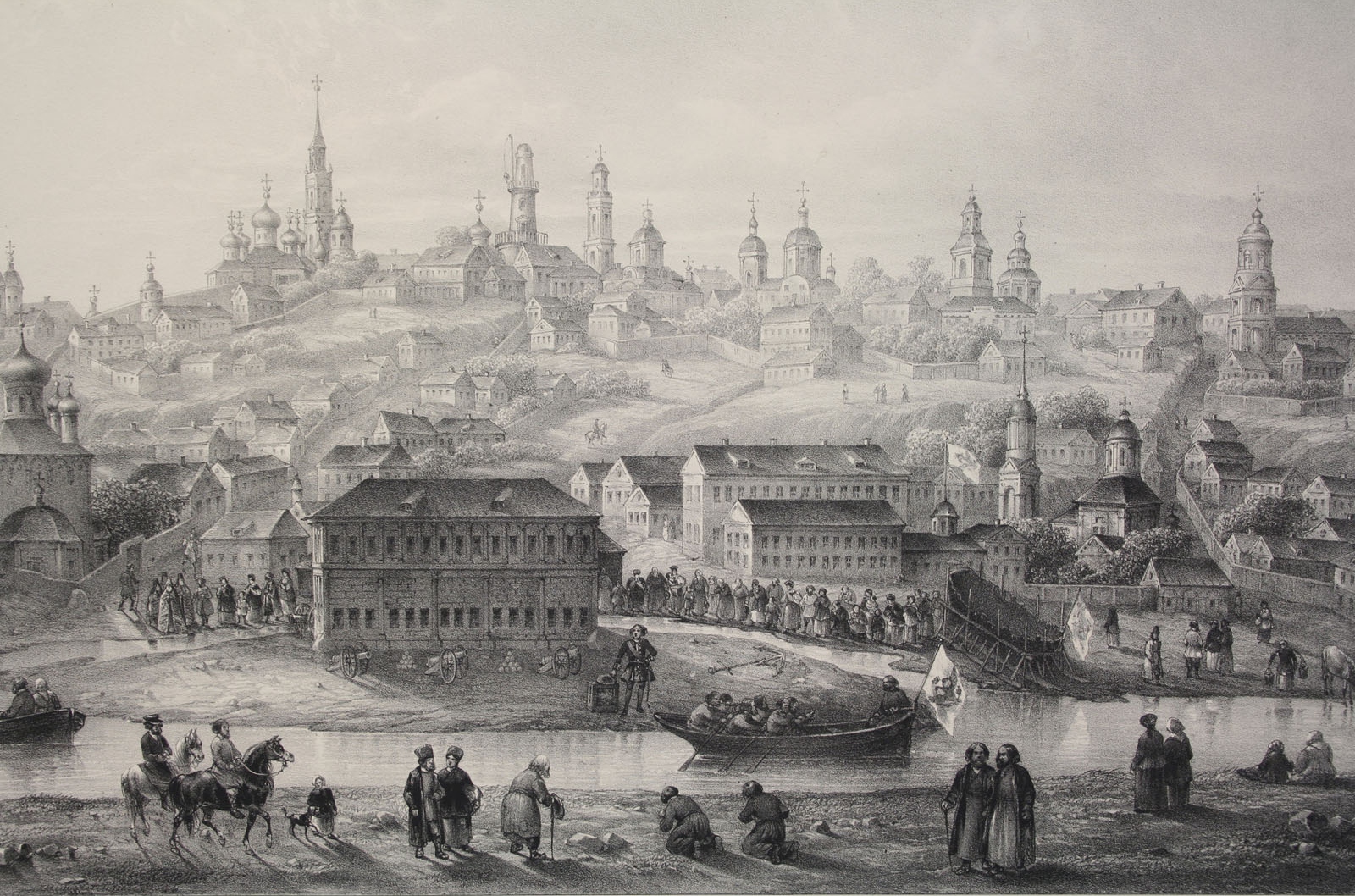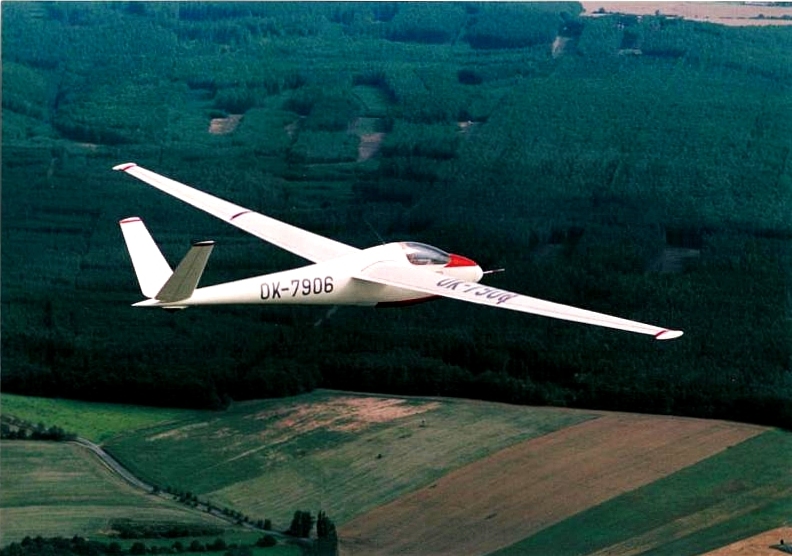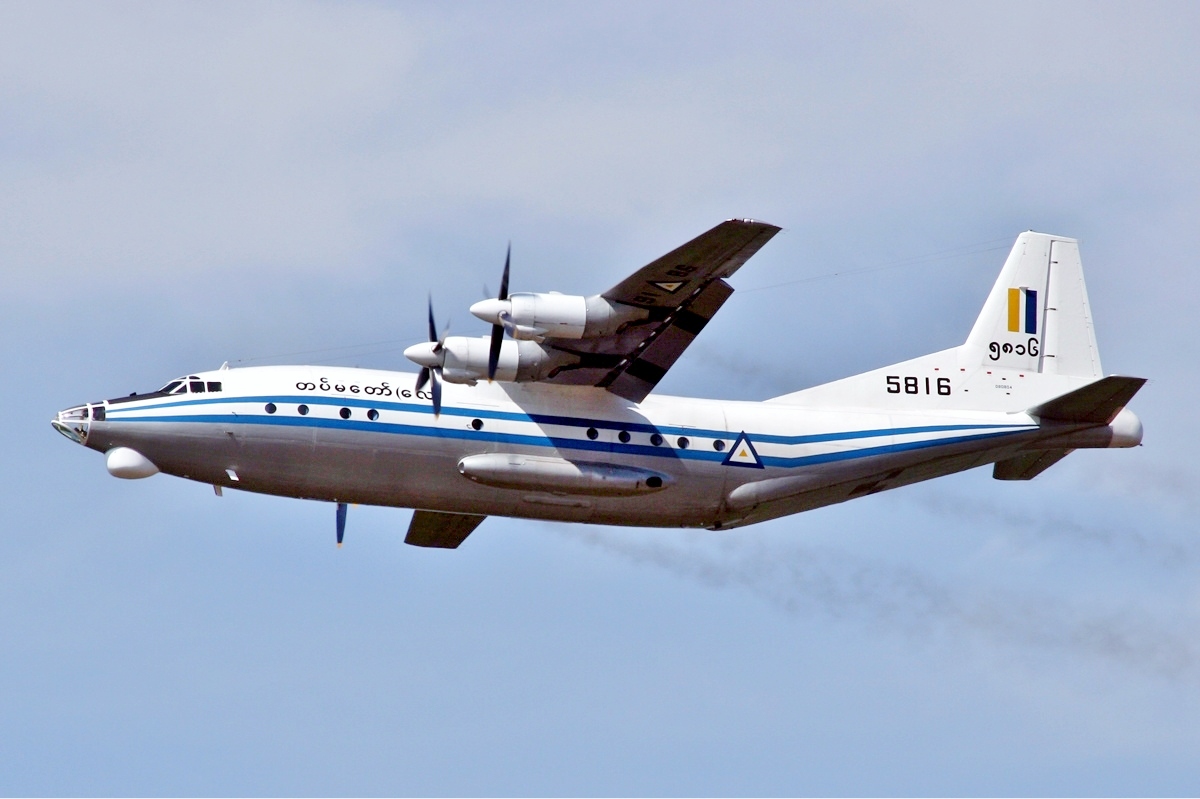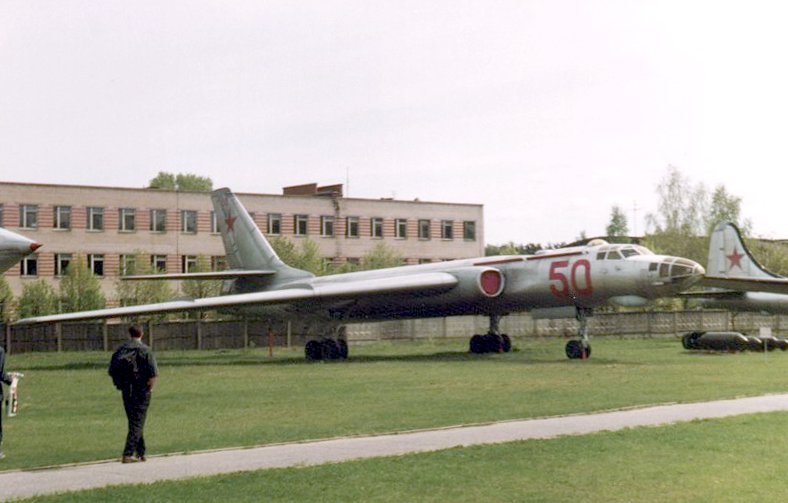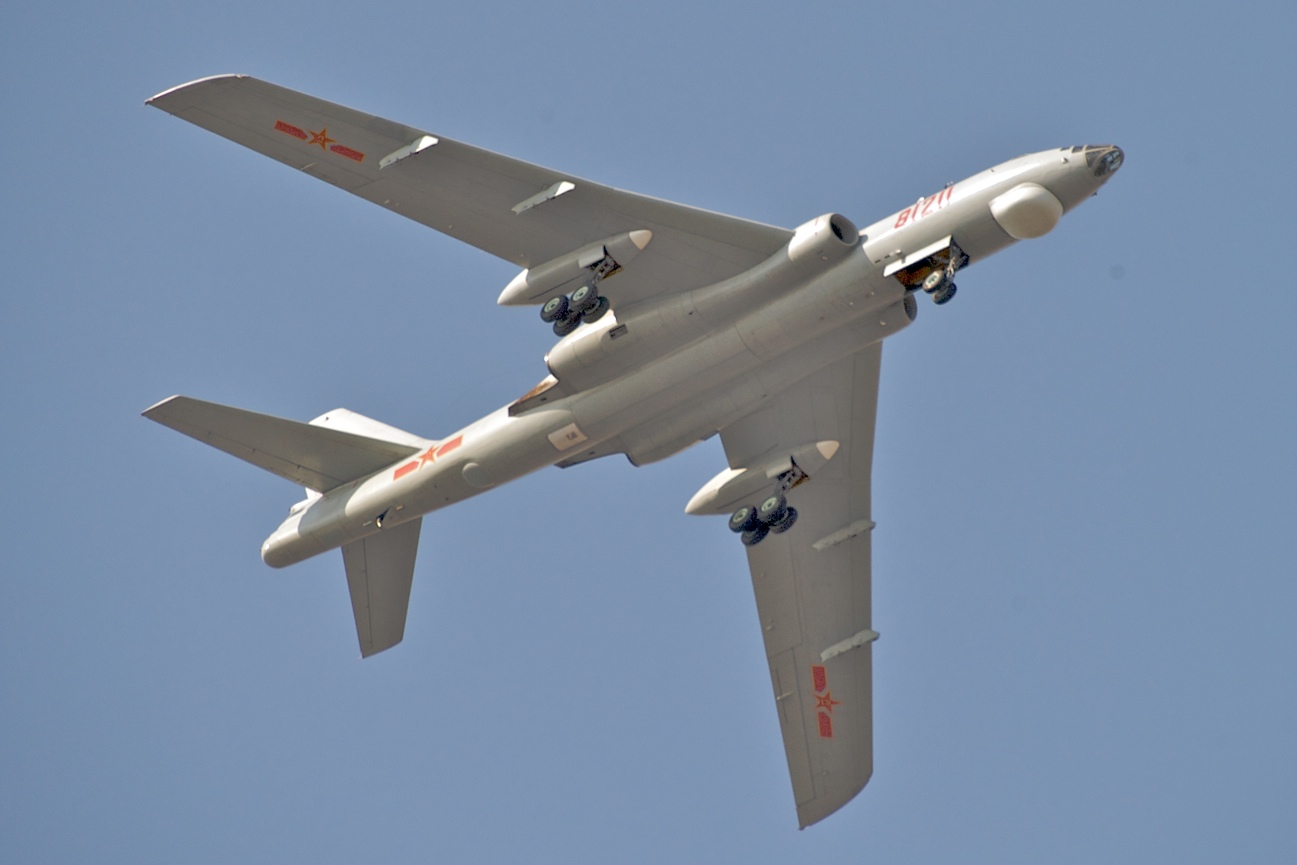|
Antonov An-12
The Antonov An-12 ( Russian: Антонов Ан-12; NATO reporting name: Cub) is a four-engined turboprop transport aircraft designed in the Soviet Union. It is the military version of the Antonov An-10 and has many variants. For more than three decades, the An-12 was the standard medium-range cargo and paratroop transport aircraft of the Soviet air forces. A total of 1,248 aircraft were built. Design and development Developed from the Antonov An-8, the An-12 was a military version of the An-10 passenger transport. The first prototype An-12 flew in December 1957 and entered Soviet military service in 1959. Initially, the aircraft was produced at the State Aviation Factory in Irkutsk, Siberia. From 1962, production was transferred to Tashkent, where 830 were built. Later, production moved to Voronezh and Kazan. In military use, the An-12 has capacity for up to 100 fully equipped paratroopers or of cargo, which is loaded through the rear loading ramp/door. In terms of conf ... [...More Info...] [...Related Items...] OR: [Wikipedia] [Google] [Baidu] |
Russian Air Force
The Russian Air Force () is a branch of the Russian Aerospace Forces, the latter being formed on 1 August 2015 with the merging of the Russian Air Force and the Russian Aerospace Defence Forces. After the dissolution of the Soviet Union, the reborn Russian armed forces began to be created on 7 May 1992 following Boris Yeltsin's creation of the Ministry of Defence (Russia), Ministry of Defence. However, the Russian Federation's air force can trace its lineage and traditions back to the Imperial Russian Air Service (1912–1917) and the Soviet Air Forces (1918–1991). History The Russian Air Force, officially established on 12 August 1912, as part of the Imperial Russian Air Service, has a long and complex history. It began as one of the earliest military aviation units globally, although its early years saw slow development due to the constraints of World War I. After the Russian Revolution, Russian Revolution of 1917, the air service was reorganised under the Soviet regime, ev ... [...More Info...] [...Related Items...] OR: [Wikipedia] [Google] [Baidu] |
Voronezh
Voronezh ( ; , ) is a city and the administrative centre of Voronezh Oblast in southwestern Russia straddling the Voronezh River, located from where it flows into the Don River. The city sits on the Southeastern Railway, which connects western Russia with the Urals and Siberia, the Caucasus and Ukraine, and the M4 highway (Moscow–Voronezh– Rostov-on-Don– Novorossiysk). In recent years the city has experienced rapid population growth, rising in 2021 to 1,057,681, up from 889,680 recorded in the 2010 Census, making it the 14th-most populous city in the country. History Foundation and name The first chronicle references to the word "Voronezh" are dated 1177, when the Ryazan prince Yaropolk, having lost the battle, fled "to Voronozh" and there was moving "from town to town". Modern data of archeology and history interpret Voronezh as a geographical region, which included the Voronezh river (tributary of the Don) and a number of settlements. In the lower rea ... [...More Info...] [...Related Items...] OR: [Wikipedia] [Google] [Baidu] |
Antonov An-12B P7-AirdropPlatform Krakau-Luftfahrtmuseum 20210907-2wp
Antonov (d/b/a Antonov Company, formerly the Aeronautical Scientific-Technical Complex named after Antonov or Antonov ASTC, and earlier the Antonov Design Bureau, for its chief designer, Oleg Antonov) is a Ukrainian aircraft manufacturing and services company. Antonov's particular expertise is in the fields of very large aeroplanes and aeroplanes using unprepared runways. Antonov (model prefix "An-") has built a total of approximately 22,000 aircraft, and thousands of its planes are operating in the former Soviet Union and in developing countries. Antonov Company is a state-owned commercial company originally established in Novosibirsk, Russian Soviet Federative Socialist Republic (RSFSR). In 1952, the company relocated to Kyiv, Ukrainian SSR, then part of the Soviet Union. On 12 May 2015, it was transferred from the Ministry of Economic Development and Trade to the Ukroboronprom (Ukrainian Defense Industry). In June 2016, Ukraine's major state-owned arms manufacturer Ukrobo ... [...More Info...] [...Related Items...] OR: [Wikipedia] [Google] [Baidu] |
Glass Cockpit
A glass cockpit is an aircraft cockpit that features an array of electronic (digital) flight instrument display device, displays, typically large liquid-crystal display, LCD screens, rather than traditional Analog device, analog dials and gauges. While a traditional cockpit relies on numerous mechanical gauges (nicknamed "steam gauges") to display information, a glass cockpit uses several multi-function displays and a primary flight display driven by flight management systems, that can be adjusted to show flight information as needed. This simplifies aircraft operation and navigation and allows aviator, pilots to focus only on the most pertinent information. They are also popular with airline companies as they usually eliminate the need for a flight engineer, saving costs. In recent years the technology has also become widely available in small aircraft. As aircraft displays have modernized, the sensors that feed them have modernized as well. Traditional gyroscope, gyroscopic fli ... [...More Info...] [...Related Items...] OR: [Wikipedia] [Google] [Baidu] |
Pratt & Whitney Canada PW100
The Pratt & Whitney Canada PW100 aircraft engine family is a series of turboprops manufactured by Pratt & Whitney Canada. Pratt & Whitney Canada dominates the turboprop market with 89% of the turboprop regional airliner installed base in 2016, leading GE Aviation and Allison Engine Company. Development The engine was first introduced as a technology demonstrator in 1977. The PW100 was first tested in March 1981, made its initial flight in February 1982 on a Vickers Viscount testbed aircraft, and then entered service in December 1984 on a Dash 8 regional aircraft for NorOntair. The PW150 engine was introduced on 24 April 1995, when Bombardier selected the engine for the launch of its de Havilland Dash 8-400 regional turboprop. The PW150 was a higher-power version of the PW100 series, with the low-pressure compressor changed from a single-stage centrifugal compressor to a three-stage axial compressor, and the turbine modified to have improved cooling. The power rating was ... [...More Info...] [...Related Items...] OR: [Wikipedia] [Google] [Baidu] |
Pratt & Whitney Canada
Pratt & Whitney Canada (PWC or P&WC) is a Canada-based aircraft engine manufacturer. PWC's headquarters are in Longueuil, Quebec, south of Montreal. It is a division of the larger US-based Pratt & Whitney (P&W), itself a business unit of RTX Corporation. United Technologies had given PWC a world mandate for small and medium aircraft engines while P&W's US operations develop and manufacture larger engines. Although PWC is a division of P&W, it does its own research, development and marketing as well as the manufacturing of its engines. The company currently has about 10,000 employees worldwide, with 6,000 of them in Canada. History The Canadian Pratt & Whitney Aircraft Company, Ltd. was founded in November 1928 to act as a service centre for P&W aircraft engines. During World War II, it assembled Pratt & Whitney Wasp series engines built in the U.S. In 1952, the production of Wasp engines was transferred to Canadian Pratt & Whitney so P&W could concentrate on developing jet en ... [...More Info...] [...Related Items...] OR: [Wikipedia] [Google] [Baidu] |
Antonov Aeronautical Scientific Technical Complex
Antonov (d/b/a Antonov Company, formerly the Aeronautical Scientific-Technical Complex named after Antonov or Antonov ASTC, and earlier the Antonov Design Bureau, for its chief designer, Oleg Antonov) is a Ukrainian aircraft manufacturing and services company. Antonov's particular expertise is in the fields of very large aeroplanes and aeroplanes using unprepared runways. Antonov (model prefix "An-") has built a total of approximately 22,000 aircraft, and thousands of its planes are operating in the former Soviet Union and in developing countries. Antonov Company is a state-owned commercial company originally established in Novosibirsk, Russian Soviet Federative Socialist Republic (RSFSR). In 1952, the company relocated to Kyiv, Ukrainian SSR, then part of the Soviet Union. On 12 May 2015, it was transferred from the Ministry of Economic Development and Trade to the Ukroboronprom (Ukrainian Defense Industry). In June 2016, Ukraine's major state-owned arms manufacturer Ukro ... [...More Info...] [...Related Items...] OR: [Wikipedia] [Google] [Baidu] |
Shaanxi Aircraft Company
Shaanxi Aircraft Corporation () is a Chinese aircraft manufacturer and supplier to the Chinese military based in Hanzhong, Shaanxi province. It is a subsidiary of the Aviation Industry Corporation of China (AVIC). Products Transports * Shaanxi Y-8 medium size medium range transport, near copy of the Antonov An-12 ** Y-8 ESM ESM aircraft ** Y-8 C3I airborne command post aircraft ** Y-8 battlefield surveillance ** Y-8 radar test bed ** Y-8 maritime patrol aircraft ** Y-8 avionics test bed ** Y-8-F600 transport * Y-9 multi-purpose transport, developed as a stretched version of the Shaanxi Y-8F with greater payload and range. The Y-9 is considered China's attempt to build a C-130J class transport aircraft. * Y-5 transport, copy of the Antonov An-2 * Y-7 transport, copy of the Antonov An-24 See also * Aviation Industry Corporation of China * Changhe Aircraft Industries Corporation * Chengdu Aircraft Industry Group * ACAC consortium * Guizhou Aircraft Industry Co. * Ha ... [...More Info...] [...Related Items...] OR: [Wikipedia] [Google] [Baidu] |
Xian H-6
The Xi'an H-6 ( zh, c=轰-6, p=Hōng-6) is a twin-engine jet bomber of the Chinese People's Liberation Army Air Force (PLAAF). The H-6 is a license-built version of the Soviet Tupolev Tu-16 and remains the primary bomber aircraft of the People's Republic of China. Delivery of the Tu-16 to China began in 1958, and a license production agreement with the Soviets was signed in the late 1950s. By November 2020, the PLAAF had as many as 231, and continued to build the aircraft. The latest variant of the H-6 is the H-6N, a heavily redesigned version capable of aerial refueling and carrying air-launched cruise missiles. According to the United States Department of Defense, this will give the PLAAF a long-range standoff offensive air capability with precision-guided munitions. History Having entered service with the Soviet Union in April 1952, the Tupolev Tu-16 was one of the Soviets' earliest effective jet bombers, with over 1,500 produced through 1962. Early in 1956, the Soviet ... [...More Info...] [...Related Items...] OR: [Wikipedia] [Google] [Baidu] |
Tu-16
The Tupolev Tu-16 (USAF/DOD reporting name Type 39; NATO reporting name: Badger) is a twin-engined jet strategic heavy bomber used by the Soviet Union. It has been flown for almost 70 years. While many aircraft in Soviet service were retired after the Cold War ended, the Chinese license-built version Xian H-6 remains in service with the People's Liberation Army Air Force, with the most modern variant, the H-6K, still being actively produced . Development In the late 1940s, the Soviet Union was strongly committed to matching the United States in strategic bombing capability. The Soviets' only long-range bomber at the time was Tupolev's Tu-4 "Bull", a reverse-engineered copy of the American B-29 Superfortress. The development of the notably powerful Mikulin AM-3 turbojet led to the possibility of a large, jet-powered bomber. The Tupolev design bureau began work on the Tu-88 ("Aircraft N") prototypes in 1950. The Tu-88 first flew on 27 April 1952. After winning a competitio ... [...More Info...] [...Related Items...] OR: [Wikipedia] [Google] [Baidu] |
Xi'an Aircraft Industrial Corporation
Xi'an Aircraft Industrial Corporation is a Chinese aircraft manufacturer and developer of large and medium-sized airplanes. It is based in Yanliang, Xi'an, Shaanxi. In 2020, under a reform, the company became a wholly-owned subsidiary of the publicly listed company, AVIC Xi'an Aircraft Industry Group (), for stock exchange purposes. The company's key clients include the People's Liberation Army Naval Air Force and People's Liberation Army Air Force. It is responsible for the production of China's biggest internally manufactured military aircraft, the Xi'an Y-20. Products Turboprops * Xi'an MA60 turbo-prop airliner * Xi'an MA600 turbo-prop airliner * Xi'an MA700 turbo-prop airliner (in development) Bombers and fighter-bombers * Xi'an H-6 twin engine bomber - Chinese-upgraded variant of the Tupolev Tu-16 Badger * Xi'an H-8 heavy strategic bomber (cancelled) * Xi'an JH-7 Flying Leopard twin engine fighter-bomber. * Xi'an H-20 heavy strategic stealth bomber; unde ... [...More Info...] [...Related Items...] OR: [Wikipedia] [Google] [Baidu] |
